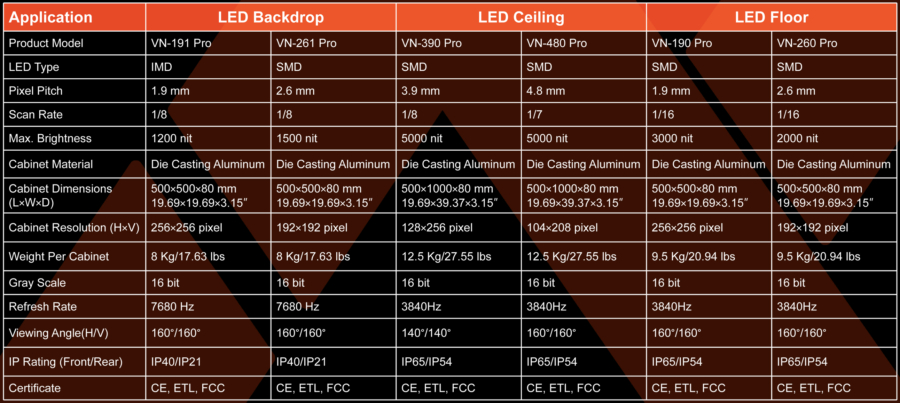In this article:
- Introduction
- Green Screens vs. LED Walls
- What is a Green Screen?
- What Is An LED Wall?
- Advantages of LED Walls vs. Green Screens in TV/Film Production: A Comprehensive Comparison
- Comparison: Green screen vs. LED wall
- How LED Walls Are Transforming Film and TV Production
- High-End Virtual Production - Introducing the Venus Pro Series of LED Display Panels from VMX Creative Display (VisionMax)
- Excellent Colour Reproduction
- HDR
- High Frame Rate & Frame Remapping
- Low Latency & Genlock
- LED Volume
- XR Stage
- Technical Specifications
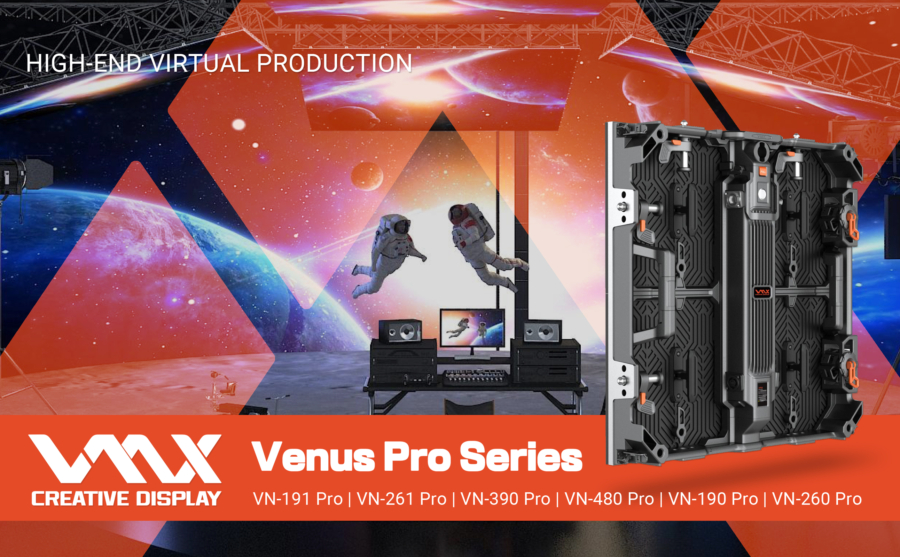
Introduction
Before we take a look at the features and technical marvels of the Venus Pro Series from VMX Creative Display (VisionMax), we’ll take a comprehensive look at how the landscape of cinema is evolving with a gradual shift towards the use of LED screens rather than traditional green screen, visual effects and lighting techniques within the Film and TV Production industry.
The gradual ascent of LED video walls is ushering in a transformative shift in the realm of film and television, gradually edging out conventional green screen technology. In scenarios where the conventional green screen falls short, the adaptable LED wall emerges as a versatile solution, crafting augmented environments for both creators and actors.
This paradigm shift presents a strategic solution to the complex logistical intricacies associated with filming locales. The versatility of LED video walls facilitates the simulation of diverse settings and modes of transportation, potentially mitigating the expenses linked to on-site shoots. By ingeniously melding your enriched environment with dynamic motion and immersive soundscapes, the craftsmanship of the special effects department culminates in an unparalleled cinematic experience.
As you witness a character seemingly aboard a train during your next cinematic indulgence, the illusion might prompt a curious pause—how is this intricately woven tapestry achieved? Such contemplation underscores the awe-inspiring ingenuity that goes into seamlessly orchestrating these elements, ultimately culminating in the remarkable visual marvels gracing the screen.
Green Screens vs. LED Walls
In the dynamic realm of film and television production, the quest for authentic background environments stands as a formidable challenge. Historically, achieving this authenticity involved location filming or the construction of intricate sets and backdrops. The advent of green screens revolutionized the industry by delivering cost-effective and time-efficient outcomes, leveraging digital technology to seamlessly incorporate environments during post-production via visual effects. In today’s landscape, propelled by the evolution of real-time technology, a novel contender has arisen: virtual production LED walls.
The unique advantages offered by LED walls present a compelling case against traditional green screens. However, it’s worth noting that green screens continue to hold their ground within the industry. The question arises: which option best serves the interests of filmmakers? This article is dedicated to a comprehensive comparison between green screens and LED walls, delving into their respective applications within the realm of film and television production.
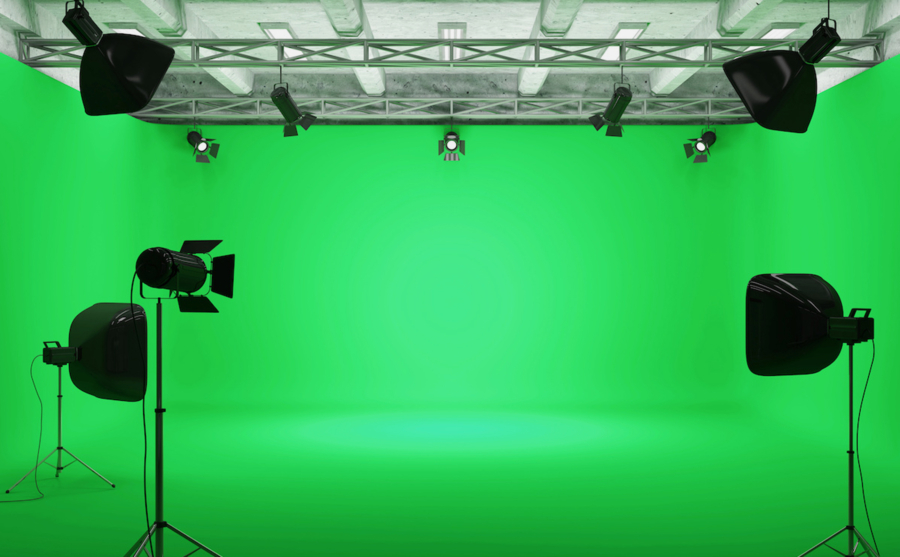
What is a Green Screen?
Green screen technology, a concept with roots spanning over a century, gained prominence in film during the 1980s, largely attributed to its innovative implementation in the iconic production “The Empire Strikes Back.”
The essence of green screen technology lies in its process: a vast green (sometimes blue) backdrop is positioned behind the scene’s action. In the realm of post-production, visual effects maestros superimpose background scenes, animations, and effects onto these green regions. This ingenious technique facilitates a realm of possibilities, transforming mere footage into dynamic environments, be it fully computer-generated imagery (CGI) settings or genuine real-world locations impractical for live shooting (think the middle of an ocean).
The applications of this technology extend further, extending its capabilities to virtually “remove” elements from the scene or an actor. This paves the way for seamless integration of CGI components during post-production. For instance, an actor can don green screen material, enabling its replacement with an extra-terrestrial physique or the strategic omission of a specific body part (like portraying a character with a digitally created amputated limb).
The versatile prowess of green screen technology enriches the filmmaking realm, expanding the horizons of creative possibilities and blurring the boundaries between reality and imagination.
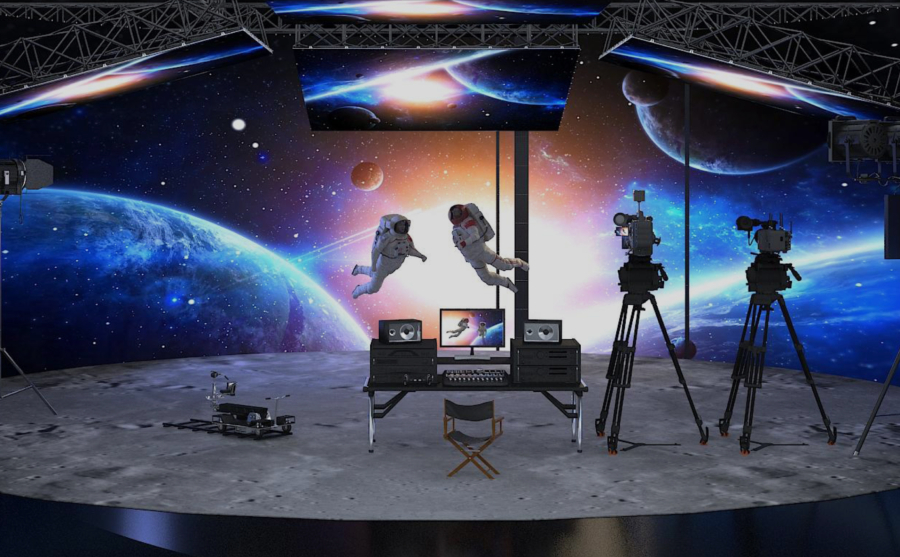
What Is An LED Wall?
The ingenious innovation of the LED wall, often referred to as a “Volume,” marks a revolutionary leap in the world of visual production. Comprising countless LEDs, this expansive curved screen envelops actors, props, and even more compact practical sets. Interestingly, the Star Wars saga played a pivotal role in popularising LED walls, with their extensive usage taking centre stage in the hit TV series, The Mandalorian, which we look at in a little more detail later on in this article.
The magic unfolds as artists harness the power of real-time 3D game engines, exemplified by Unreal Engine, to conjure the very “worlds” that constitute the scene. These digital realms are seamlessly projected onto the LED walls, enveloping actors and foreground set pieces. The visual orchestration is further elevated by virtual cameras that synchronize with live-action cameras, orchestrating a symphony of on-screen harmony.
This ingenious arrangement brings forth an array of benefits. LED walls usher in realism like never before, drenching scenes in lifelike illumination. This obviates the necessity for elaborate, sprawling lighting setups on set, streamlining the production process. What’s more, real-time 3D artists share the stage with directors, actors, and the entire crew during principal photography.
What is a real-time 3D artist?
The role of a Real-time 3D Artist encompasses a dynamic fusion of traditional craftsmanship within various facets of the production pipeline. Their expertise is channelled into crafting content and assets, specifically within the realm of real-time environments like game engines. While the foundational skill sets remain consistent, the distinction arises in the shift from real-time to non-real-time production contexts.
Leading the charge among programs utilised by real-time artists is Unreal Engine, an industry staple. This platform serves as the virtual canvas where the artist’s talents come to life. Notably, Unreal Engine stands out for its seamless integration of physical precision within settings and values. This intrinsic accuracy becomes a cornerstone, facilitating an effortless transition from the tangible world into the immersive realms of the virtual domain.
In this burgeoning era of digital creativity, Real-time 3D Artists wield their skills to bridge the gap between the traditional and the technologically advanced, shaping captivating narratives and visual masterpieces.
This dynamic collaboration enables instantaneous adjustments to the digital “world,” obviating the waiting game that often accompanies post-production tweaks.
From The Mandalorian’s galactic landscapes to the broader spectrum of visual storytelling, LED walls stand as a testament to innovation’s power to reshape the art of filmmaking.
Advantages of LED Walls vs. Green Screens in TV/Film Production: A Comprehensive Comparison
When it comes to TV and film production techniques, making the decision between LED walls and conventional green screens can significantly influence the final output’s quality, efficiency, and realism. In this article, we delve into the primary benefits of utilizing LED walls, highlighting their superiority over green screens from an SEO-optimized perspective:
Real-Time Visuals and Immersive Interaction
LED walls offer an unparalleled advantage with their ability to provide real-time visual backdrops that seamlessly interact with actors and scene elements. In contrast to green screens, which necessitate time-consuming post-production editing and compositing, LED walls instantly generate immersive environments. This real-time interactivity heightens actor performances by allowing them to naturally respond to their surroundings.
Enhanced Realism and Consistent Lighting
A standout feature of LED walls is their capability to emulate realistic lighting conditions. Traditional green screens often present challenges in maintaining uniform lighting across actors and backgrounds during post-production. LED walls emit dynamic, accurate lighting that harmonizes naturally with the scene, reducing the requirement for extensive lighting adjustments during post-processing.
Time and Cost Efficiency in Production
LED walls prove to be efficient time and cost savers in the production process. While green screens demand extensive post-production work to replace backgrounds, align lighting, and ensure visual cohesion, LED walls streamline this effort by creating a cohesive environment during filming itself. This reduction in post-production demands minimizes the need for reshoots and accelerates the overall production timeline.
Seamlessly Integrating VFX and Practical Effects
LED walls smoothly integrate visual effects (VFX) and practical effects, enabling actors to seamlessly interact with digital elements. This integration significantly enhances scene authenticity, eliminating the challenge of actors responding to invisible or incomplete elements against green screens.
Elevating Actor Performances
LED walls provide tangible surroundings for actors to engage with, yielding more authentic performances. Actors can respond organically to the environment, thus enhancing their emotional depth and connection to the scene.
Reflections and Natural Ambient Lighting
Another advantage of LED walls is their ability to reflect light and color onto actors and objects, replicating natural ambient lighting. Traditional green screens lack this natural interaction, often requiring intricate color grading and manual adjustments to achieve realistic lighting effects.
Consistency in Simulating Dynamic Environments
LED walls maintain their visual excellence across varying external conditions, making them ideal for replicating dynamic and outdoor environments. Green screens can be impacted by changing weather, lighting fluctuations, and external elements, leading to unpredictable outcomes.
In summary, LED walls offer an array of compelling benefits over conventional green screens in TV and film production. From real-time visuals and heightened realism to time and cost efficiencies, LED walls redefine the production process, yielding more authentic performances and visually captivating results. As you explore the optimal choices for your production needs, the superiority of LED walls becomes evident in transforming your creative vision into a captivating reality.
Comparison: Green screen vs. LED wall
Both filmmaking technologies are widely used today, and each has ideal use cases depending on the creative brief. Here is a comparison summary of the two technologies:
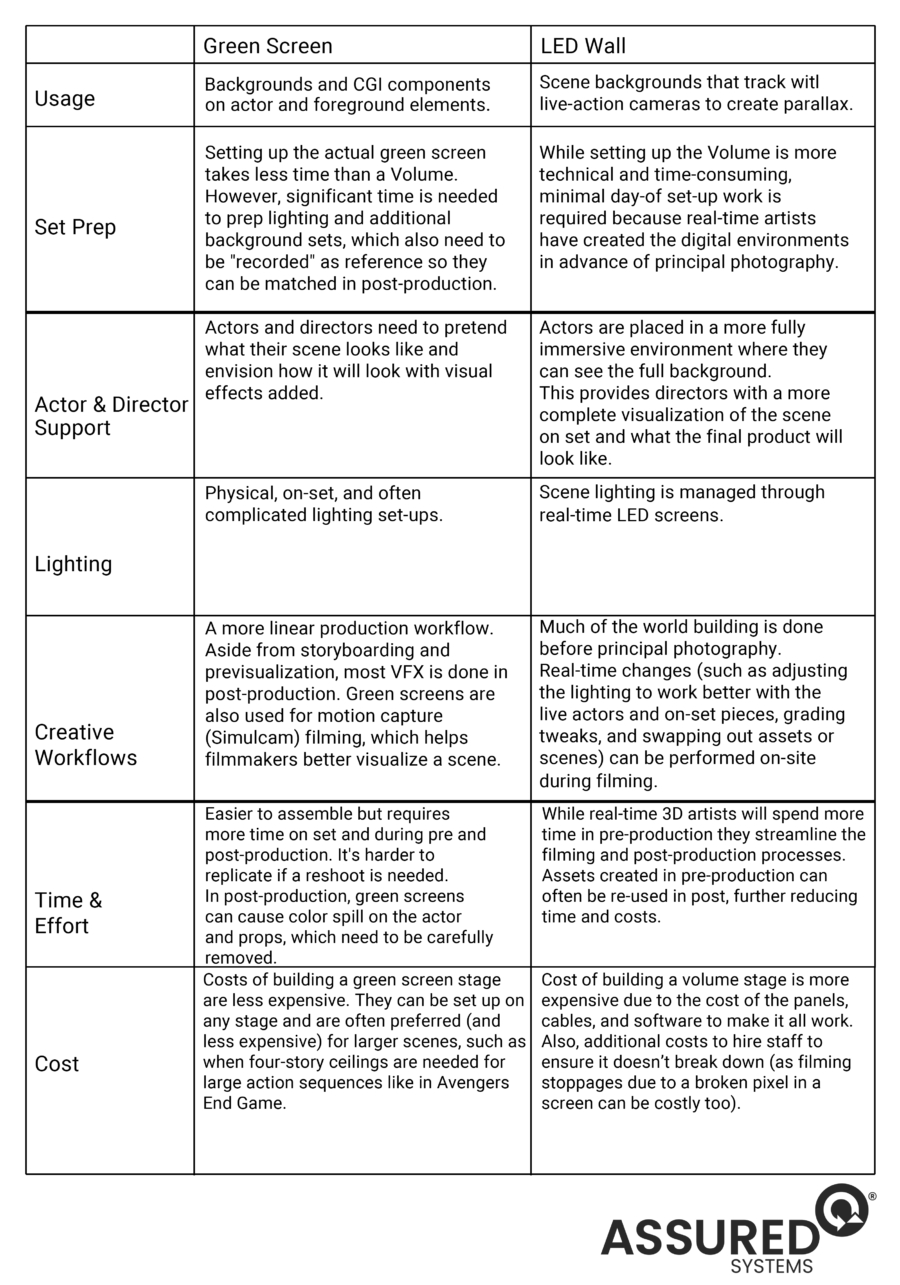
How LED Walls Are Transforming Film and TV Production
Creating hyper-realistic illusions
Back in 2013, the cinematic sensation known as “Gravity” stood as a trailblazer in harnessing 3D LED environments for crafting captivating and immersive encounters, catering to both performers and viewers alike.
One of the paramount hurdles confronted by the film’s creators was the replication of the intricate hues and weightlessness of space. This obstacle loomed large as the production predominantly unfolded beyond the confines of Earth’s atmosphere. The starring roles portrayed by Sandra Bullock and George Clooney depended not only on their aptitude for engaging with their surroundings but also on conjuring the perception of being adrift in a cosmic whirl.
The ingenious resolution to these quandaries was devised and executed by the film’s adept cinematographer, Emmanuel ‘Chivo’ Lubezki, in collaboration with the accomplished visual effects supervisor, Tim Webber. Assisted by the adept team at Framestore, their brainchild took the form of The Light Box—an expansive structure standing 20 feet tall and 10 feet wide. This remarkable enclosure comprised an array of 196 LED video panels, courtesy of VER. Within the confines of The Light Box, proficient visual effects technicians could orchestrate the LEDs to project dynamic Earth visuals, orchestrating swift transitions in video and illumination. The orchestrated spectacle fostered the illusion of the enclosure gracefully pirouetting through the cosmos.
The tangible outcome of this innovation speaks volumes, as “Gravity” clinched a plethora of esteemed accolades, notably several Academy Awards. These included recognition for Best Visual Effects and Best Cinematography. Furthermore, Sandra Bullock’s portrayal earned her a nomination for the distinguished title of Best Actress, a testament to her captivating role within the cinematic marvel.
Dynamic Lighting
In the realm of cinematic innovation, “Gravity” introduced another ground-breaking technique to its arsenal, one that has since reverberated in films such as “Deepwater Horizon” and Christopher Nolan’s masterpiece “Dunkirk.”
This ingenious method involved leveraging the luminance of video-generated light on LED screens to achieve the dynamic illumination requisite for simulating off-camera fires. This technique circumvented the limitations of conventional special effects tools, particularly when replicating the distinct hues of oil fires. Instead of relying on artificial effects, the strategy entailed projecting authentic footage of oil fires onto LED video walls. The ensuing ambient radiance from these displays faithfully emulated the genuine fiery glow, attaining unparalleled authenticity. Worth noting is that these LED video walls remained inconspicuous to the camera lens, functioning solely as luminous sources for crafting lifelike lighting atmospheres.
In a parallel realm, the team behind Netflix’s acclaimed series “House of Cards” ingeniously harnessed off-screen LED video walls to instil dynamic luminosity into the fabric of the show. When filming against a green screen, the perpetual challenge lies in harmonizing the tangible lighting conditions with the backdrop that will be composited into the frame. This hurdle amplifies when the context encompasses moving vistas like landscapes glimpsed through a moving car’s window.
To surmount this conundrum, the astute production designer, Steve Arnold, together with the innovative “House of Cards” crew, seamlessly merged LED and green screen methodologies for the driving sequences within the series. The endeavour began with an expedition to Washington, D.C., where they captured authentic driving perspectives throughout the city. Subsequently, this recorded footage was played back on strategically positioned LED screens above the car (and discreetly outside the camera’s view) within their green screen studio. The emitted luminosity from these screens cast authentic reflections onto the actors’ countenances, the window frames, and the door structures. During the post-production phase, the green screen backdrops were seamlessly substituted with genuine scenery. Remarkably, the synchronisation between the filmed shots and the light interplay from the LED screens yielded a stunningly realistic visual marvel.
These instances stand testament to the constant evolution and inventive fusion of technology within the cinematic landscape, as well as the profound impact such innovation has on crafting truly immersive and authentic storytelling.
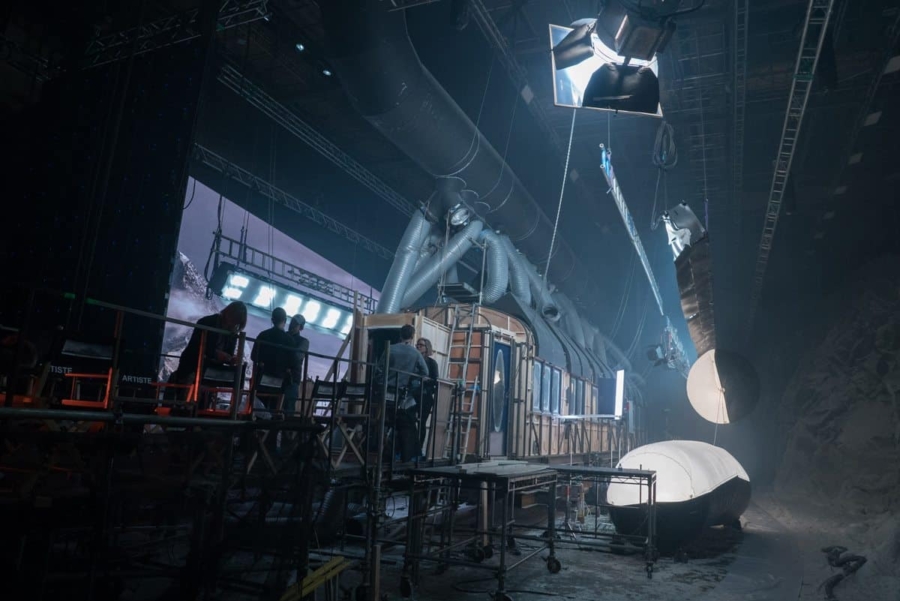
Virtual LED Production Sets
Innovative LED video walls find a remarkable application in crafting “enhanced environments,” stepping in where traditional back-projection and green screen methodologies fall short. This ingenious utilization is brilliantly exemplified by the creative minds responsible for bringing Agatha Christie’s “Murder On The Orient Express” to life in its fourth cinematic adaptation.
Due to the intricacies and logistical challenges entailed in filming aboard the authentic Orient Express, the decision was made to shoot the film at London’s Longcross studios. This production hub accommodated a 30-ton locomotive along with a fleet of meticulously crafted replicas, providing a higher degree of filming flexibility. The meticulously adorned train sets, adorned with abundant bevelled glass and reflective surfaces, posed a formidable challenge for post-production background compositing. To circumvent this daunting task, a collaborative effort ensued involving cinematographer Haris Zambarloukos, VFX supervisor George Murphy, VER’s luminary Paul Kobelja, and enhanced environment technical consultant Bobby Finley III. Together, they devised an ingenious LED-based alternative.
This ingenious team embarked on a pioneering journey to evoke the illusion of the train’s passage through the Alpine landscapes. Their strategy encompassed projecting footage of a scenic journey through the majestic mountain ranges of New Zealand onto a network of 2000 meticulously arranged LED panels enveloping the stationary train set. Augmenting this setup, the special effects team engineered an adaptable hydraulic system to replicate the train’s motion. This hydraulic choreography was synchronized seamlessly with the backdrop footage. Consequently, the radiance emanating from the LED panels, as it interacted with the train’s surfaces, harmonized seamlessly with the motion depicted through the window LEDs. The culmination of this endeavor yielded a remarkably lifelike experience that resonated with both the actors and the audience. In an intriguing twist, the authenticity of the effect was so compelling that certain actors reportedly grappled with motion sickness during filming.
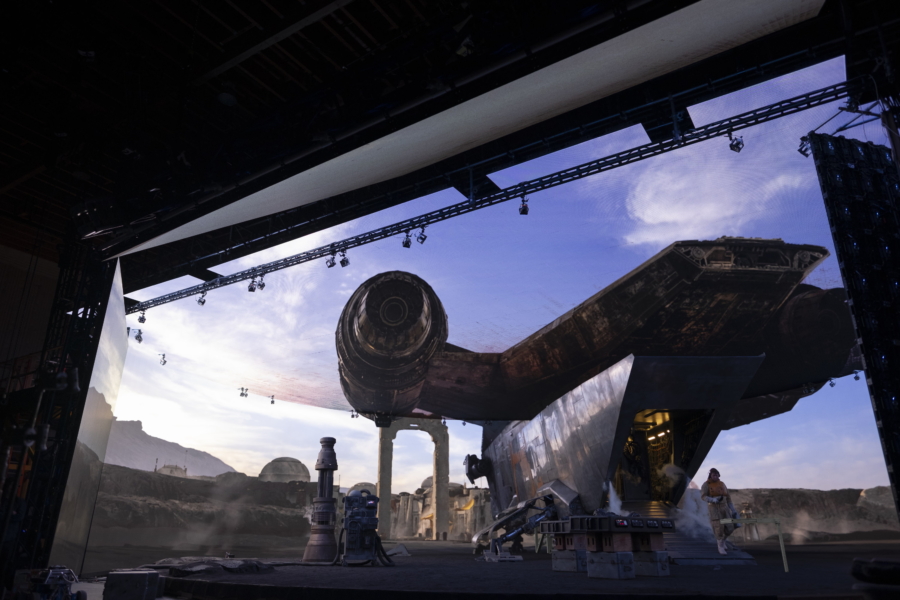
Real time, In-camera VFX
Leading the forefront of visual-effects craftsmanship, Industrial Light & Magic (ILM) has propelled the realm of LED backdrops to unparalleled heights through their ground-breaking work on the set of “Star Wars: The Mandalorian.” This Disney+ series marks a milestone, seamlessly intertwining tangible performances with digital landscapes.
Elevating the artistry, ILM harnessed the power of Epic Games’ Unreal Engine to conjure virtual realms that unfurled within the show’s narrative tapestry. These digital vistas materialized on an awe-inspiring 21-foot-high by 75-foot-long curved panoramic LED wall, a technological marvel that served as a canvas for actors to enact their roles. This captivating interplay was further enriched by the presence of practical effects props—iconic blasters and swift speeder bikes—imbuing the performance with a tangible authenticity.
The luminous tapestry, graciously provided by Fuse, enveloped the set with a sense of immersion that transcended traditional confines. This immersive setup facilitated an unbounded creative horizon. The ingeniously concocted virtual backdrops, dynamically manipulable and instantaneously updatable via real-time manipulation, conferred the production team unprecedented autonomy to conceive in-camera visual effects that seamlessly harmonized with the actors’ performances.
In essence, ILM’s visionary endeavour, epitomized by “Star Wars: The Mandalorian,” serves as a testament to the synergistic convergence of technology and storytelling artistry. The creation of an intertwined live-action and digital universe, underpinned by the synergy of practicality and innovation, reverberates as a paradigm shift within the cinematic landscape.
Summary
Undoubtedly, the cinematic and television landscape is merely embarking on the journey to fully harness the creative potential inherent in LED video walls. The trailblazing examples set by the visionary pioneers discussed earlier serve as a wellspring of inspiration propelling this burgeoning evolution.
High-End Virtual Production - Introducing the Venus Pro Series of LED Display Panels from VMX Creative Display (VisionMax)
Virtual Production Within An Immersive LED ‘Wall’
The Venus Series Pro allows for a virtual set construction for the ceiling, floor and wall, allowing for the placement of both actors and props, as well as lighting rigs and any other equipment required for a scene.
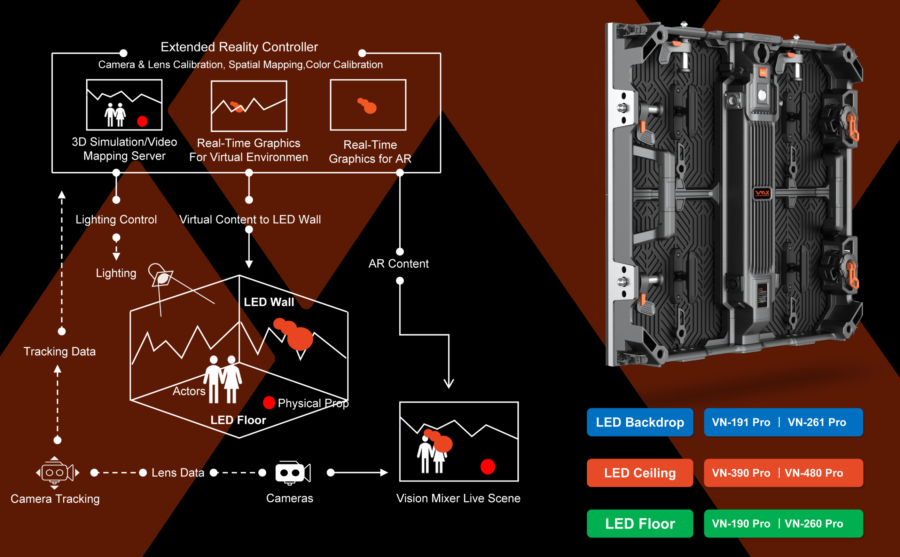
The following table outlines the impressive technical specifications of each panel type including the mind boggling refresh rate of up to 7680Hz.
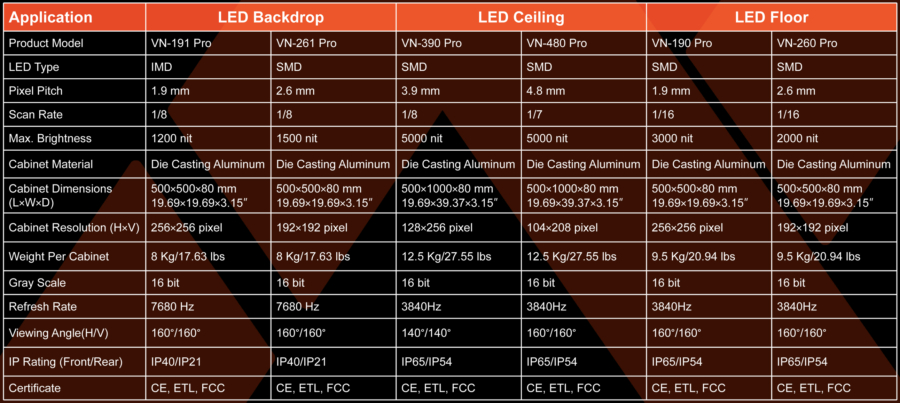
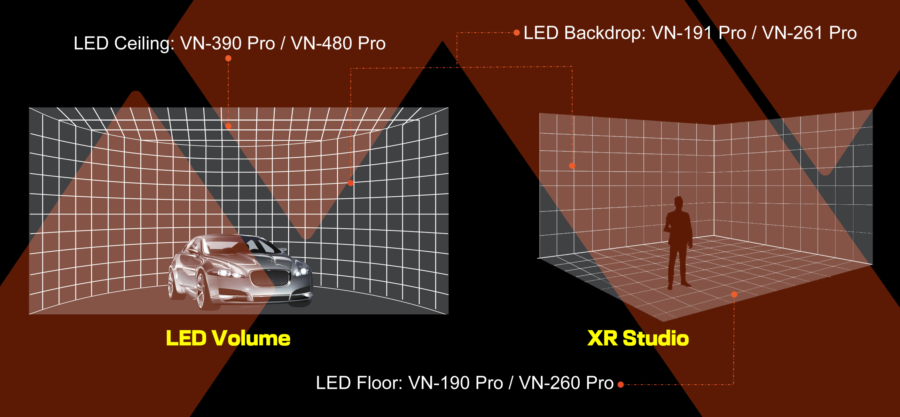
Excellent Colour Reproduction
The LED Panels feature the use of 3rd Generation Mini LED- LED Technology with Integrated Matrix Devices…
- 4-in-1 pixel integration
- 5 times higher strength
offering the ability to be able to shoot great ICVFX (In-Camera Visual Effects) with ultra-high nits available, pure colour, low off-axis colour shift and impressive viewing angles of 160°/160°(H/V). The LEDs also offer ultra-black technology, reduce moire effect and reflection, and with a DCI-P3 rating of 98% (DCI-P3, formally known as Digital Cinema Initiatives – Protocol 3, is a colour space commonly used in digital cinema and is the color standard for the film industry.)
HDR
Lifelike Colour and Brightness without Compromise.
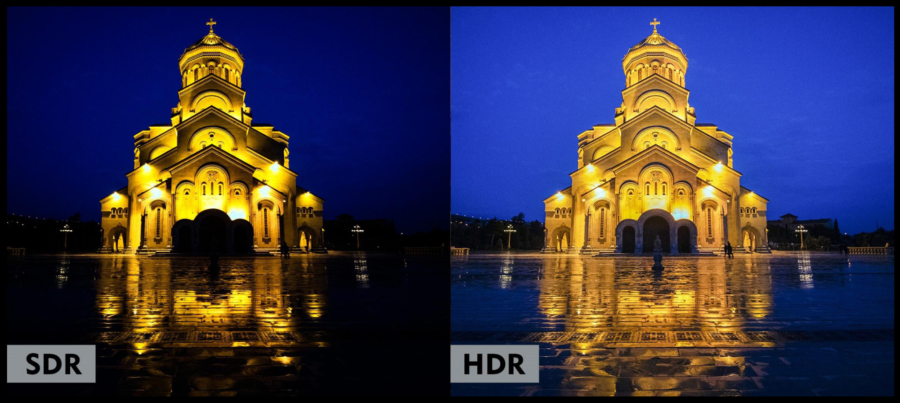
High Frame Rate & Frame Remapping
1/8 scan and supports maximum 250FPS, better black level performance.
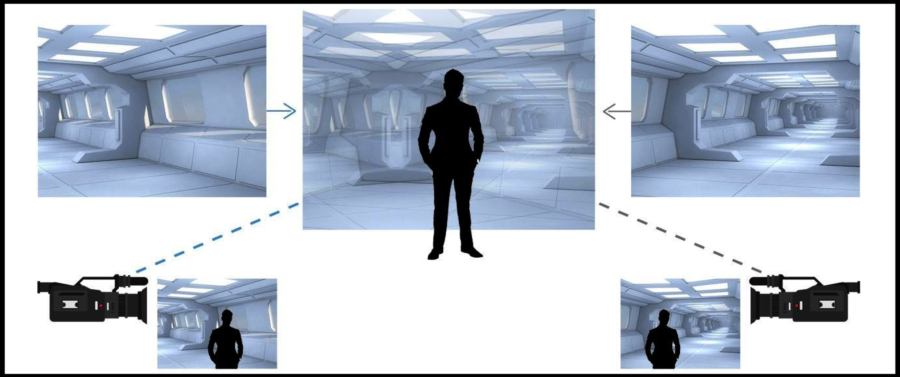
Low Latency & Genlock
Provides a better on-camera performance by preventing the unsightly rolling black bars.
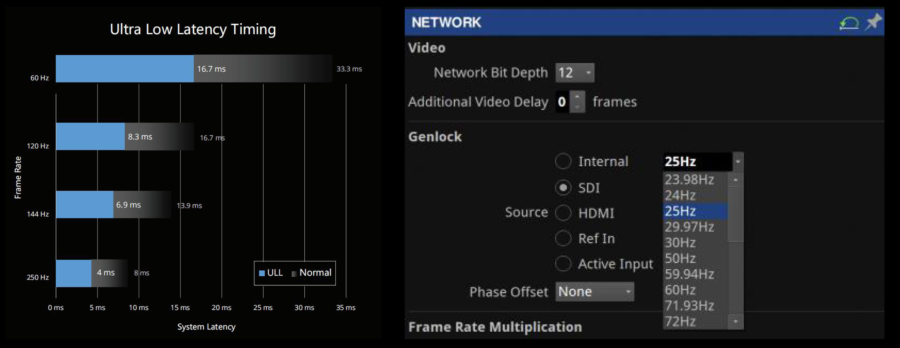
LED Volume
- Live Action Shooting with LED Wall instead of Green Screen
- 270° Curved Backdrop Screen (VN-191 Pro / VN-261 Pro)
- LED Ceiling for environmental lighting and reflections (VN-390 Plus / VN-480 Plus)
- Filmmaking / TV Drama / Immersive Advertisement / Commercial Shooting / MV Shooting.
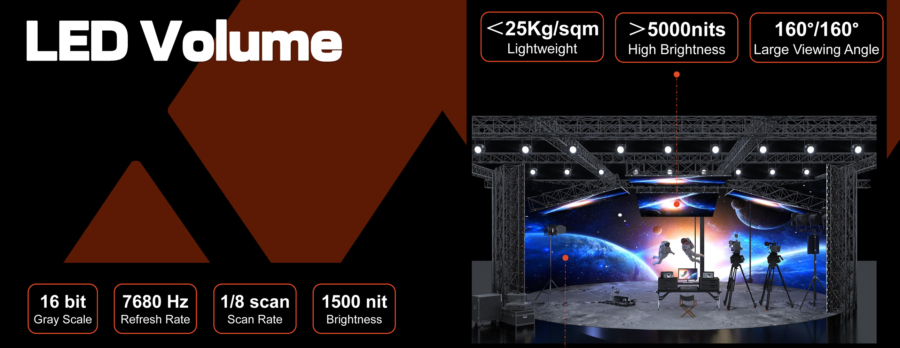
XR Stage
- Uses Real-time Rendering to create rendered environment outside of physical LED Wall, replacing the real scene and Green Screen
- Two Perpendicular Backgdrop Screens or Single Curved Background Screen (VN-191 Pro)
- LED Floor (VN-190 Pro / VN-260 Pro)
- Great for small spaces, Live Events just as Corporate Event / Webinar / Conference / Product Launch / Keynote / Summit / On-line Musical Performance /
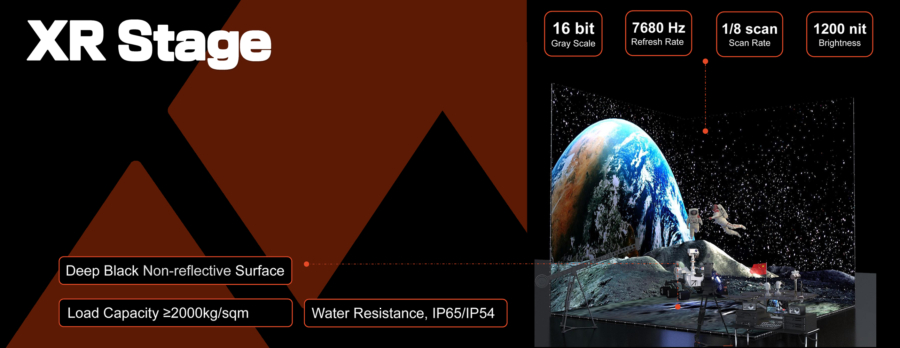
Technical Specifications
